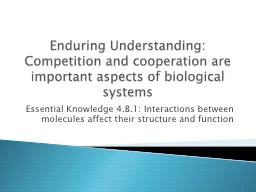PPT-Enduring Understanding:
Author : luanne-stotts | Published Date : 2016-07-22
Competition and cooperation are important aspects of biological systems Essential Knowledge 4B1 Interactions between molecules affect their structure and function
Presentation Embed Code
Download Presentation
Download Presentation The PPT/PDF document "Enduring Understanding:" is the property of its rightful owner. Permission is granted to download and print the materials on this website for personal, non-commercial use only, and to display it on your personal computer provided you do not modify the materials and that you retain all copyright notices contained in the materials. By downloading content from our website, you accept the terms of this agreement.
Enduring Understanding:: Transcript
Download Rules Of Document
"Enduring Understanding:"The content belongs to its owner. You may download and print it for personal use, without modification, and keep all copyright notices. By downloading, you agree to these terms.
Related Documents














